Table of Contents[Hide][Show]
This effective, simple, and easy to make homemade fly trap can be assembled in minutes with an empty soda bottle and some old produce as bait. Outdoor protection during any season of the year including summertime picnics.
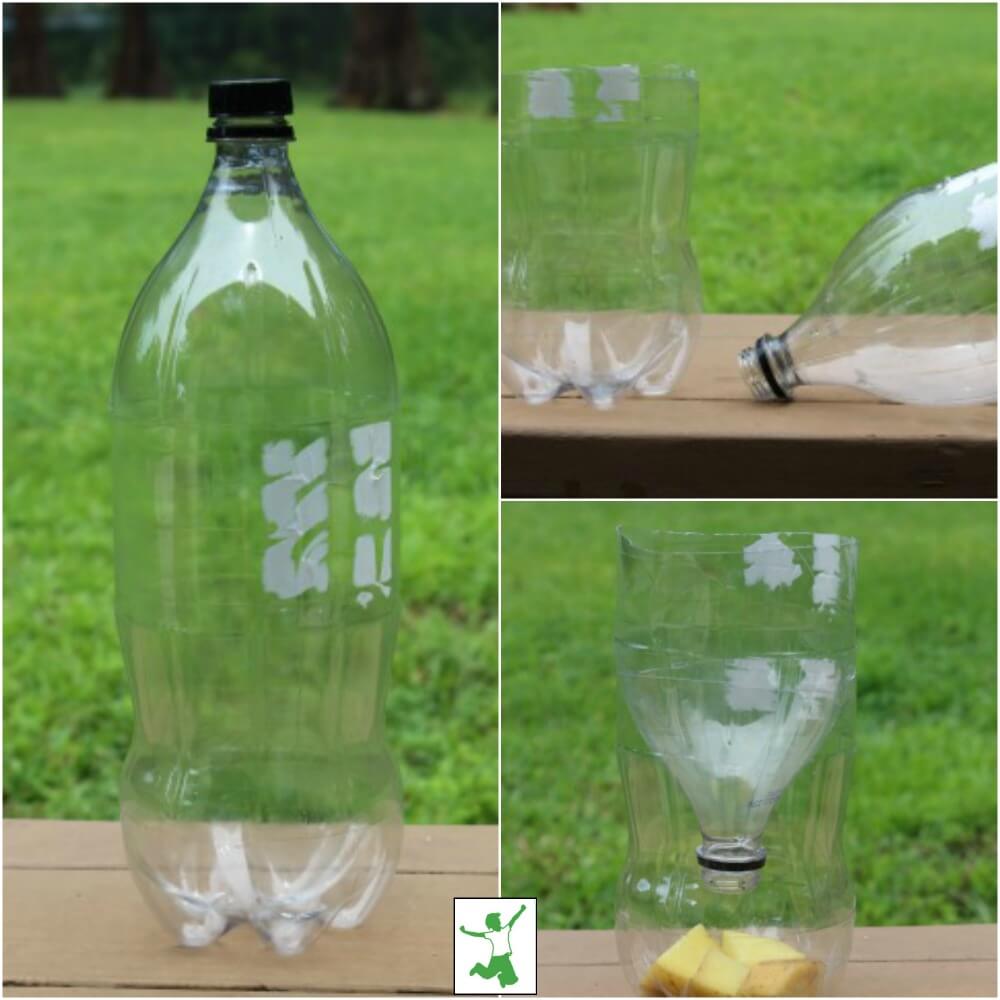
No matter where you live in the world, there is probably at least part of the year when a fly trap is very much needed! If repelling flies alone isn’t getting the job done, this DIY method is sure to take up the slack.
Are you are one of the folks for whom the water and a penny in a heavy duty ziplock bag aren’t working to eliminate your fly issues? If so, try this different fly trap instead. It is easy to make and the three steps shown in the picture above are described below.
The idea is courtesy of my goat milk farmer who uses it with fantastic success. The picture above shows just how many flies it will trap over the period of a few days!
As you can see, the fly trap obviously works well as the picture is of one of the traps behind my goat farmer’s house. It is loaded with several inches worth of dead house flies!
The trick to this fly trap is that it actually catches and traps the flies rather than repelling them like the flybag approach.
The flies get lured into the trap by a potential food source and can’t escape. Bones leftover from making bone broth work well as does old produce.
When the fly trap becomes full of flies, you throw it away and make another one, or two, or three!
Note: If larger biting flies are more of a problem in your area, use this homemade deer fly trap instead.
DIY Fly Trap in 3 Simple Steps
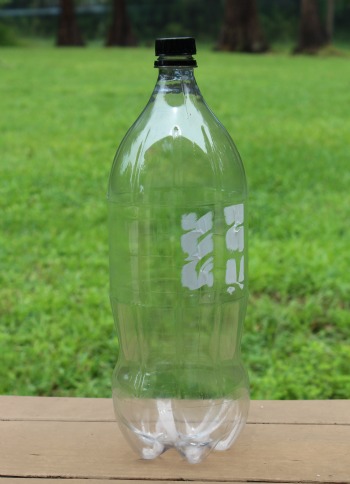
The only supplies you need to make your fly trap are a clean, empty 2-liter plastic soda bottle, some heavy duty packing tape, and some bait. Rotting potatoes work really well for my farmer. The pictures included with the steps show how quickly you can make your homemade fly trap.
- Cut an empty 2-liter soda bottle in two. The bottom half should be larger than the top. Making the cut about 1/4 – 1/3 of the way down the bottle works well (see photo below).
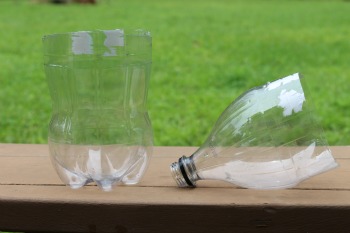
- Remove the cap from the top of the bottle and turn it upside down. Place a few pieces of cut up, rotting produce in the bottom half of the bottle and then, place the upside down, open end of the bottle inside the bottom half (see photo).
- Tape the two halves of the bottle together so they stay secure.
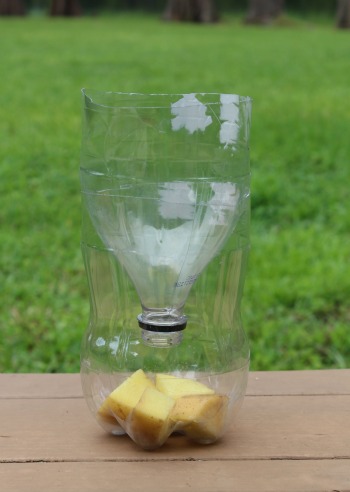
Tips for Using Fly Trap Most Effectively
Note that the better the bait, the more effective these fly traps will be. Here in Florida, potatoes that are soft and starting to rot work extremely well. Any type of decomposing fruit or vegetable would work too – you can try different ones and see which attract flies in your locality most effectively.
Here’s what it will look like after the flies start swarming.
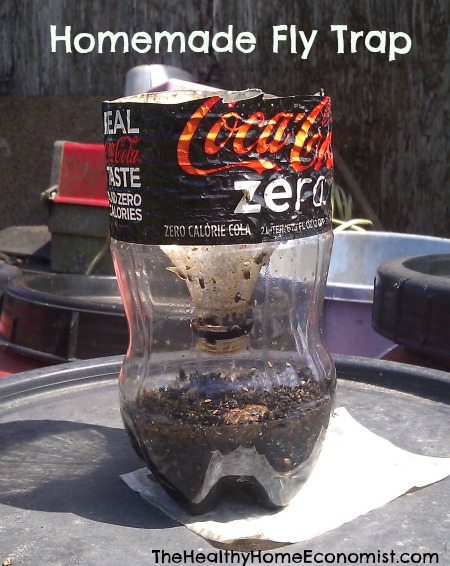
Because you are using rotting food to attract and trap the flies, make sure you place the homemade fly trap in a place where the smell won’t bother you or the neighbors. The trick is to put it in a place close enough to attract the flies away from the area you are trying to keep fly free, but far enough away so you don’t smell or see it. In my experience, the trap will attract flies from a radius of about 50-100 feet/ 15-30 meters.
Let me know if you have tried this approach where you live and what you use as bait inside the soda bottle. Did you find it worked well?
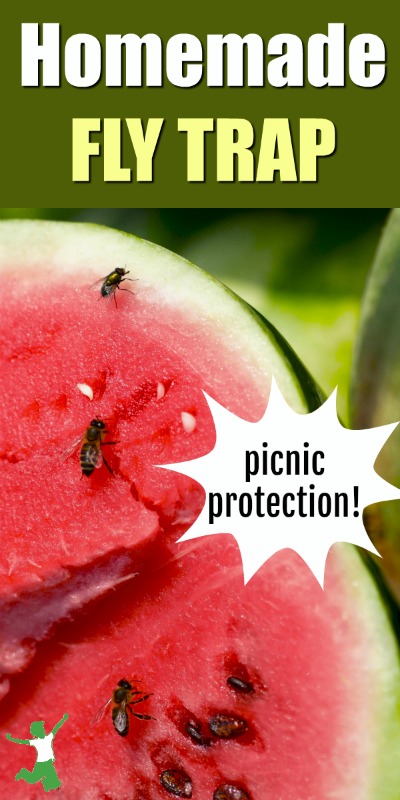
Natural Insect Control FAQ
Easy, Safe Tick Removal
Nontoxic Pest Control Ideas that Work
Natural Bed Bug Removal
Nontoxic Carpenter Ants Removal
Natural Fire Ant Killer That Works FAST
Ladybugs for Garden Pest Control
Natural Flea Infestation and Prevention Strategies
Spider Repellent Guaranteed to Work
Fast Acting Mosquito Bite Remedy








We use this trap with just water, a bit of sugar, and dry (bread) yeast. It works great for catching flies in our house and does not require rotting food! (Sydney, Australia)
Sir please tell me that is is essential to keep that trap on sunny place or not and putting of dry bread is essential or not.
Pretty sure this person is referring to dry yeast, as in the kind used to bake bread. Yes, it would be pretty crucial to the recipe.
Sun attracts the flies but is not essential
They are attracted more by the smell of sugar or rotting food – meat or potatoes. They are also attracted by the smell of yeast.
can meji bottles be used
I’m in Southern California, next door to a horse ranch, and the black flies sneak into the house all the time. And they bite! I didn’t have a liter bottle, but I found a plastic water bottle. I also didn’t have any rotting fruits or veggies, but for one tiny, moldy clementine. I put that in the bottom of the bottle with a splash of wine left over in the fridge (how did that even happen?). Within five minutes, a fly was trapped. I am hoping it takes care of the problem…I hate flies in the kitchen!
As far as the fly types it catches in my yard, 99.9% are green bottle and blue bottle flies (AKA blow flies) and a few house flies. Other extremely tiny fly types I could not identify were also lured but in very few numbers. But overall i love this flytrap http://bit.ly/1Gy10TX and will continue to use it.
We do the bottle trick with soda to catch yellow jackets too. You can actually just set a half drank bottle of soda (Mountain Dew works best for us) and it’ll start filling up with them without even cutting and flipping the lid.
From my experience these homemade traps don’t really work for reducing a mosquito population in a yard. I much better prefer professional mosquito traps that lure mosquitoes by imitating a human breath releasing carbon dioxide, which are a lot more expensive but also much more effective.
This trap is for flies, not mozzies.
I live in Maryland. I am trying to rid my house of flies. I used red wine and rotting peaches and is not working. Any suggestions?
you can use the same trap for mosquitoes just change the bait. Try 1/4 cup brown sugar, 1 cup warm water, 1/4 tsp yeast.
You can use the bottle trap also … Use apple cider vinegar with a dab of brown sugar instead of the rotting potatoes . 🙂
Screwdrivers aren’t effective at hammering nails into lumber, either.
We used exactly this method in hope to catch some flies for our aquaponics setup 🙂 Fingers crossed!
weeksfamilyeco.org/blog/2015/april/fly-catcher-deployment/
Hi. I’ve used this type of bottle trap to catch wasps outside near the house. Everyone in our house is severely allergic &/or very phobic, so we wanted to keep our house’s small deck useable for us. First yr we baited it with some partly cooked meat in a small amt of water with unscented dishsoap, and hung it in a tree a couple meters/yards away from the porch. The water evaporated quickly, but there were a few dead wasps in it by then, and it seemed to work better for them with the dead ones as bait. (Are wasps canabalistic? Never heard, but it made me wonder.) Since then at the beginning of the season I make a new trap, baited with just meat, then let them act as bait for the others for the rest of the season. Not 100%, but it does noticeably help reduce the wasps.
Never thought of that type of trap for flies until recently however, after we had to switch to wet cat food only for our cats for health issues, and had problems with flies attracted since. Because they seem drawn to the cat food, I’m going to try using a combo of wet cat food added to other fly bait recipes I’ve seen until I find a combo that works… I hope.soon! But if the effectiveness I saw with wasps is any indication, if I can find the right bait, it should be good..
What someone else said about flies having compound eyes – I’ve read that too, and that it results in them only seeing motion & light, and they are drawn to light, so I suspect this type of trap would probably work best if made from transparent bottles rather than tinted ones.
That’s so weird that the flies can’t figure out how to get out of the bottle once they’re inside.
Or do they just love the rotting potato so much that they don’t bother trying to escape?
The placement of the hole is key. Its very small and at the point. The flies will wander around the edge until they die. Like a fly on a window trying to get thru.
It is the same principal as a minnow trap : Because the ‘outlet’ is suspended at the bottom of the angle , they can’t find it … A few may but NOT many ! 🙂
Ive seen plenty if ideas for fruit flies and house flies but does anyone kniw what kind of attractant would work for.horse flies.and deer flies? We live in the forest and these pesky insects are swarming my poor horses weve tried several home made insect repellants with no luck and.commercial bug repellant works.good for mosquitoes and sand flies but doesn’t seem to phase the horse and deer flies
i have a friend who own horses and he uses skin so soft oil from Avon. it mixes it with vasoline and puts it in ears to stop mites.
Deer flies and horse flies hunt by sight/motion. This trap is supposed to be the best method.
I LOVE Google ! Found this , it should help you . 🙂 Tabanids lie in wait in shady areas under bushes and trees for a host to happen by. Sight is the main host finding mechanism, but carbon dioxide and odor also play a role. Moving objects, especially if dark colored, are most prone to attack. Attacks occur during daylight hours with a peak beginning at sunrise and lasting three hours. A second peak is two hours before sunset and commences shortly after. Attack frequency is low on overcast days or at temperatures below 22 and above 32 ºC. On livestock, biting occurs on the abdomen, legs, and neck. Tabanids inflict deep wounds that cause a flow of blood. The mandibles and maxillae penetrate the skin in a scissor-like action. Anticoagulants in the saliva are pumped into the wound and the blood is ingested through the sponging labella. Pathogens may be transmitted from flies that are disturbed while feeding on one animal and begin feeding on another. It is known that deer flies can mechanically vector Tularemia and Loa loa, and horse flies transmit Anthrax. Fly attacks result in lowered gains and low milk production in livestock animals. In 1976, estimated losses in the United States were at 40 million dollars. One cattle ranch in Kentucky lost an average 100 lbs. per animal due to tabanids. It is not uncommon to see as many as 100 flies feeding on an animal at one time. Twenty to thirty flies feeding for six hours are capable of taking 100 cc of blood.